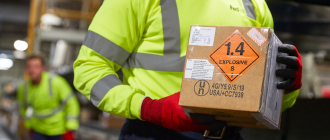
From Batteries To Chemicals: What You Need To Know About Dangerous Goods Logistics
By FedEx | First published: July 2, 2020 Updated: October 2, 2025
By understanding the basics of dangerous goods logistics and following hazardous materials guidelines, your business can stay compliant while ensuring every shipment reaches its destination safely.
- Many everyday products, including lithium batteries, perfumes, and cleaning agents, are classified as dangerous goods for shipping and must adhere to international regulations.
- Dangerous goods are categorized into nine UN hazard classes, each requiring specific packaging, labeling, and documentation.
- Working with an experienced logistics provider like FedEx helps businesses stay compliant with hazardous materials guidelines while ensuring shipments are delivered safely and on time.
Did you know that perfume, oil paint, art kits, lithium batteries, and even laptop computers are all classified as dangerous goods during transport?
Dangerous goods and hazardous substances can be hiding in plain sight – often without you realizing it. From everyday items like smartphones and other battery-powered devices to industrial chemicals and medical supplies, many shipments fall into this category and are frequently overlooked. Under some circumstances, these common products can pose serious risks to people, property, and the environment.
For businesses that want to expand across borders without running into costly delays, penalties, or compliance issues, understanding dangerous goods logistics is essential. Whether you’re shipping hazardous materials for personal or commercial purposes, it’s crucial to be aware of the regulations and the necessary safety precautions to take.
What is considered dangerous goods for shipping?
Dangerous goods are items or substances that could pose a risk to health, safety, property, or the environment when transported. While you might immediately think of explosives or toxic chemicals, the reality is that many common products are classified as dangerous goods for shipping. Some examples include:
- Lithium batteries found in laptops, mobile phones, and e-bikes
- Perfumes and nail polish containing flammable liquids
- Hand sanitizers and cleaning agents with alcohol content
- Aerosol sprays such as deodorants or paint
- Fertilizers, pesticides, and industrial chemicals
Global regulators for air transport, such as the International Air Transport Association (IATA) and the International Civil Aviation Organization (ICAO), set the hazardous materials guidelines that businesses must follow. Misclassifying or overlooking these rules can result in fines, rejected shipments, or safety hazards.
Types of dangerous goods
Dangerous goods are divided into nine classes, namely:
- Class 1: Explosives (e.g., fireworks, flares)
- Class 2: Gases (includes compressed, liquefied, or dissolved gases)
- Class 3: Flammable liquids (e.g., gasoline, solvents, alcohol-based products)
- Class 4: Flammable solids, substances liable to spontaneous combustion, and substances that emit flammable gases on contact with water (e.g., matches, magnesium)
- Class 5: Oxidizing substances and organic peroxides (e.g., hydrogen peroxide, ammonium nitrate fertilizers)
- Class 6: Toxic and infectious substances (e.g., medical waste, biological samples)
- Class 7: Radioactive material (e.g., medical isotopes, uranium)
- Class 8: Corrosives (e.g., acids, batteries with corrosive electrolyte)
- Class 9: Miscellaneous dangerous goods (e.g., lithium batteries, dry ice)
Each category has its own set of regulations and packaging requirements, so it’s essential to identify the correct classification for your shipment. For SMEs, the challenge lies in keeping track of these regulations while managing cross-border shipments. By identifying your dangerous goods and packaging them correctly in every shipment, you’re protecting both your shipment and yourself.
How to ship dangerous goods
Does your business ship items that fall under these nine categories? We've put together a list of things to consider before handling and shipping dangerous goods:
1. Identify and classify your shipment
Refer to the IATA’s Dangerous Goods Regulations (DGR) and ICAO’s guidelines to identify and classify your goods correctly. Proper classification includes determining the UN or ID number, proper shipping name, hazard class, and, if applicable, subsidiary risk and packing group.
2. Package your shipments correctly
Some dangerous goods have very specific packaging, labeling, and marking requirements that you’ll need to meet. For example, lithium batteries must be packaged in special containers with clear hazard labels. Plan ahead and pack your shipments correctly with a Shipper’s Declaration for Dangerous Goods form.
The hazmat packaging market is constantly evolving, offering stronger, more sustainable, and compliant solutions. Logistics providers like FedEx offer packaging options and expert guidance to help businesses better comply with hazardous goods packaging standards.
3. Avoid penalties for incorrect packaging or labels
Regulatory compliance is non-negotiable when it comes to dangerous goods, so make sure you aren’t caught off-guard. Shippers who fail to prepare packages in accordance with regulations may experience delays, risk fines from regulatory authorities, and even face criminal prosecution and imprisonment.
Stay up to date with guidelines from the IATA (for air shipments), ICAO (for aviation safety standards), and the United Nations (for dangerous goods classification and transport regulations).
4. Work with a reliable logistics provider
Managing dangerous goods shipping doesn’t have to be overwhelming. Working with an air freight or logistics company that is experienced in handling dangerous goods can take some of the pressure off.
Whether you’re an SME shipping small volumes or a larger enterprise with frequent hazmat shipments, FedEx provides the expertise and global network to keep your business moving safely across borders. With decades of experience in navigating complex regulations, we ensure full compliance and provide guidance on packaging, labeling, and documentation, helping you save time and avoid costly mistakes.
For businesses shipping dangerous goods, we deliver region- and market-specific services across Asia Pacific and beyond. Our convenient one-stop services cover the entire shipment process, from initial classification assistance to preparing clearance documents, arranging specialized packaging, liaising with airports, and handling pickup and delivery.
Most SMEs lack specialized knowledge in this area, so outsourcing to a trusted provider like FedEx can save time and eliminate the need for a third-party agent or middleman.
Dangerous goods, delivered safely
Dangerous goods are everywhere, and shipping them safely requires expertise, compliance, and the right logistics support. By understanding what is considered dangerous goods for shipping, recognizing different types of dangerous goods, and adhering to hazardous materials guidelines, businesses can avoid disruptions and focus on growth.
FedEx provides end-to-end dangerous goods logistics solutions, designed to simplify the shipping process and give you peace of mind that your shipments will arrive safely and on time.
Open a FedEx account today to start shipping with confidence.
SHARE THIS STORY
- 85% Of APAC Businesses Plan To Expand Into Europe, According To New FedEx Report
- Generative AI: A New Frontier
- How To Ship A Giant Panda
- The Rise Of Intra-Asia Trade: Opportunities In The China-Southeast Asia Corridor
- Where Do Old Planes Go When They Retire?
- What’s So Dangerous About Coconuts? Your Guide To Dangerous Goods Logistics
Sign up now and save on your shipping rates!
Sign up now and earn discounts by shipping instantly with FedEx Ship ManagerTM at fedex.com.
Recommended For You

What’s So Dangerous About Coconuts? Your Guide To Dangerous Goods Logistics
Every country has strict regulations for dangerous goods logistics. Did you know that dried coconut, thermometers, and perfumes are dangerous goods?
Read More
8 Most Unusual Shipments In The History Of FedEx
From priceless artifacts to live animals, FedEx leverages its global network to ship rare and unusual items.
Read More
Mastering Customs Clearance In Asia Pacific: Why Agility And Accuracy Are The New Trade Imperatives
Learn how to clear customs seamlessly and understand current regulations with our comprehensive customs compliance guide.
Read More
